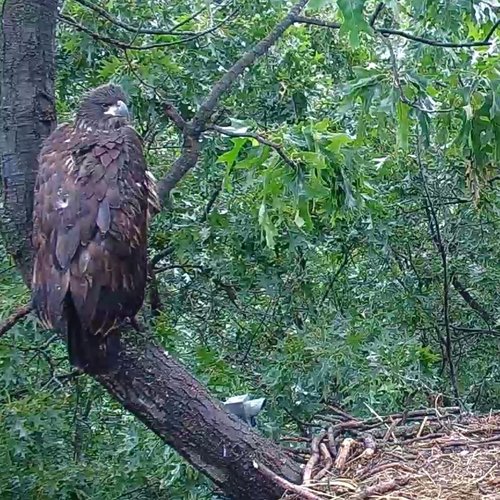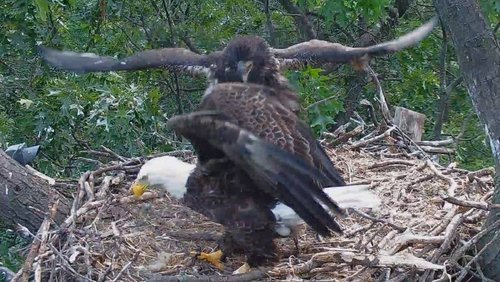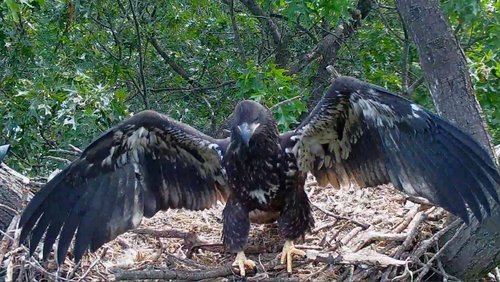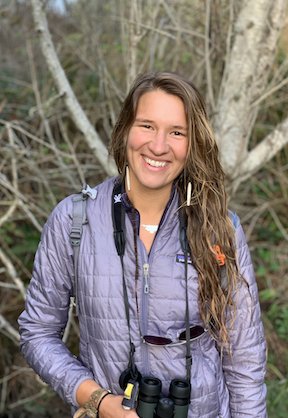Hanover Bald Eagle Blog # 23 - 2021
In partnership with Pennsylvania Game Commission and Comcast Business .
THIS WEEK MARKS THE BEGINNING OF A NEW ERA FOR THE HANOVER EAGLET. ON MAY 30TH THE EAGLET LEAPT INTO THE UNKNOWN, AND WHILE MANY VIEWERS FELT UNDERSTANDABLY CONCERNED FOR THE LITTLE ONE’S WELL-BEING, IT’S HELPFUL TO REMEMBER THAT EAGLES HAVE BEEN SUCCESSFULLY JUMPING OUT OF NESTS FOR CENTURIES.
FLEDGING IS RARELY A GRACEFUL EVENT. THE PROCESS IS MORE OF A BUMBLING TUMBLE RATHER THAN AN ELEGANT SWAN DIVE OFF INTO THE SUNSET. IN FACT, MANY FLEDGLINGS SPEND THE FIRST DAYS OF THEIR FREEDOM PERCHED ON THE GROUND UNTIL THEY IMPROVE THEIR FLIGHT SKILLS. THE HANOVER FLEDGLING, HOWEVER, SEEMS TO BE SKIPPING THIS GROUND PHASE!
The fledgling will now explore new areas, hone flight skills, and embark on a journey of trial-and-error until they grow into their adult personality. Although most of us cannot witness their first exploratory hops and jumps, they are undoubtedly working through the awkward stage of fledgling-hood and flight school as we speak. Fledglings sometimes use their nest as a home base while practicing and continue to beg for food until they are officially cut off by their parents.

Begging calls, which alert the Hanover parents to the location of the fledgling, will decrease as the youngster begins feeding itself. This period, called the postfledging dependence period, usually lasts between 4-11 weeks, though males tend to disperse sooner than females. The eaglet usually remain within a mile of their nest for the first 6-8 weeks. Around 17-23 weeks of age, the relationship between the Hanover eaglet and the parents will dissipate, and eventually each individual will go their own way. This dispersal will likely be gradual as the eaglet gains comfort exploring outside the nesting grounds.
The Hanover eaglet will develop hunting skills at their own pace. Like other social scavengers, young eagles observe adults, an integral part of the learning process during their first year of life. By taking notes and trying things out, the Hanover eaglet will hopefully gain the skills necessary to survive the most perilous year of their life. Mortality for first-year bald eagles is over 50% but the good news is that their chance of survival increases dramatically after that.
Eaglets harass their parents and steal food from them, which helps explain why bald eagle parents are not very welcoming to their offspring once rearing duties are done. This kind of harassment is a natural “adolescent” behavior that, while undoubtedly annoying for the parents, counts as experiential learning. Eagles possess a telltale scrappiness and creativity that allows them to thrive in a variety of circumstances, and these traits are understandably better tested on parents first and strangers later. Right now is a great time for the Hanover fledgling to perfect their feistiness. It will come in handy during the winter when bald eagles routinely duel for food. Research shows that in southeast Alaska, hungry eagles choose to steal fish from other eagles, even when dead fish were readily available. The researcher for this study suggested that this may be because stealing food is an inherited behavior, and eagles are programmed to practice even when they don’t have to.

By the final weeks in the nest, the eaglet became very possessive of all the food scraps in the nest.
In addition to winning battles, flight coordination is an important prerequisite for successful hunting, and while many juvenile bald eagles rely heavily on carcasses at first, they must eventually learn to catch their own food. For Pennsylvanian bald eagles, year-round resources are not a guarantee. Many eagles depart during the wintertime, flying south to access open water and avoid snow-covered ground, which can make carcasses difficult to detect. Juvenile bald eagles learn how to feed themselves on the fly (literally and metaphorically) by taking advantage of landfills, butcher scraps, and literally anything edible they can find until they develop adequate fishing techniques (eagles have even been observed fighting over bread in lean years). Bald eagles are also surprisingly efficient runners, and juveniles utilize a combination of clumsy flight, ground maneuvering, and jumping during their initial foraging forays.

The next year will be a wild ride for the Hanover eaglet — they have steep learning curves ahead and a long way to go before establishing their own territory and attracting a mate. But with such capable parents for teachers, and with their robust size, we can rest easy. This little one has a strong chance of joining the ranks of healthy Pennsylvania bald eagles and will likely contribute to the population for years to come, which is no small feat, considering that bald eagles were nearly wiped off the face of the Earth not that long ago.
Humans have been persecuting bald eagles for over a century, both directly (shooting) and indirectly (poisoning and incidental trapping while targeting wolves and other bounty species). Eagles began recovering in the 1930’s and 1940’s with the creation of wildlife refuges and the establishment of the Bald Eagle Protection Act, however in 1946, a new threat surfaced: DDT, a pesticide developed following WWII that was widely sprayed to control salt marsh mosquitoes. The effects were calamitous. By the 1960’s, bald eagles were on the edge of extinction, and many feared the species would become a symbol of the past, living on only in stories. But with persistent efforts from individuals like Charles Broley and Rachel Carson, DDT was finally banned in 1972 and eagle populations (not to mention other species devastated by DDT including peregrine falcons) began to rebound. Today, bald eagle recovery remains one of the most dramatic conservation stories in wildlife history.
As eagle enthusiasts, we can support bald eagles by supporting the environment they live in. Because they are top predators, bald eagles are indicative of environmental health. As opportunistic scavengers and fish specialists, they interact with many habitats during their lifetime and their success speaks to the ecological integrity of their surroundings. We can also help bald eagles by spreading the word about the human-caused dangers they still face today, illegal shooting and lead poisoning being the most detrimental.
THIS WEEK, WE BID THE BELOVED HANOVER EAGLET A FOND FAREWELL, AND TAKE SOLACE IN THE FACT THAT ALL SIGNS POINT TO A STRONG FUTURE FOR THIS INQUISITIVE, SIZEABLE, BEAUTIFUL BIRD. WE LOOK FORWARD TO WELCOMING THE HANOVER PARENTS HOME NEXT YEAR, AND IN THE MEANTIME…BON VOYAGE H313, AND MAY THE VIRTUE OF PATIENCE BE WITH YOU!
Sources
Buehler, D. A. (2020). Bald Eagle (Haliaeetus leucocephalus), version 1.0. In Birds of the World (A. F. Poole and F. B. Gill, Editors). Cornell Lab of Ornithology, Ithaca, NY, USA. https://doi.org/10.2173/bow.baleag.01
Ellis, David H. (1979). Development of Behavior in the Golden Eagle. Wildlife Monographs, 70, 394-486.
Gerrard, Jon M. and Bortolotti, Gary R. (1988). The Bald Eagle, Haunts and Habits of a Wilderness Monarch. Smithsonian Institution.
O’Toole, Laura, T. et al. (1999). Postfledging Behavior of Golden Eagles. The Wilson Bulletin, 111(4), 472-477.
ATTENTION HANOVER EAGLE VIEWERS - We recognize that over the years this bald eagle pair has been named by the public and is commonly referred to as "Freedom" and "Liberty". While we understand that naming the eagles helps connect and distinguish the female from the male eagle, naming the pair introduces an element of domesticity to wild animals. In order to respect the eagles and focus on their natural history, we will refer to the female and male as such as per recommendations of the Pennsylvania Game Commission.

RAPTOR ECOLOGY SPECIALIST - ZOEY GREENBERG
RETURN TO HANOVER BALD EAGLE BLOGS
WATCH THE HANOVER BALD EAGLE LIVE CAMS
For over 20 years, HDOnTap has provided live streaming solutions to resorts, amusement parks, wildlife refuges and more. In addition to maintaining a network of over 400 live webcams, HDOnTap specializes in design and installation of remote, off-grid and otherwise challenging live streaming solutions. Contact press@hdontap.com for all media needs, including images and recordings.